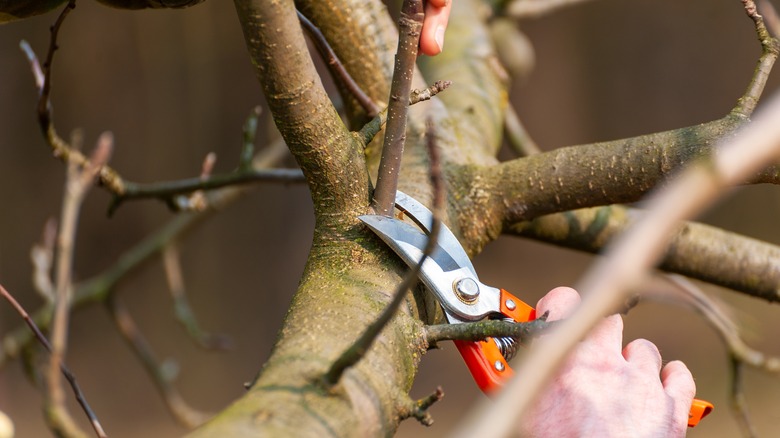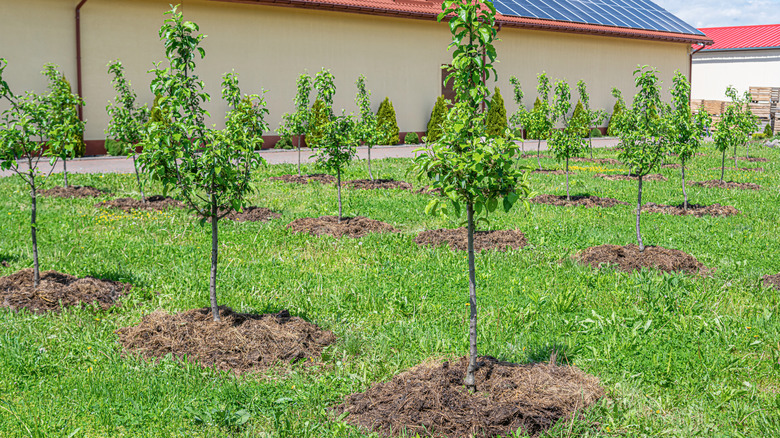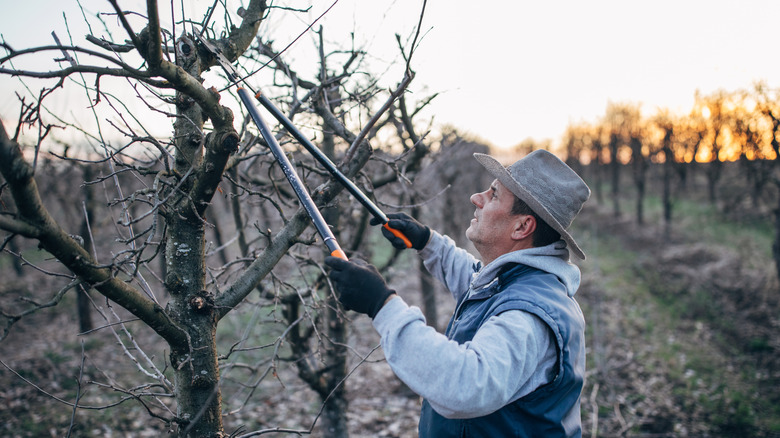The Best Time To Prune Your Apple Tree For More Fruit
The old saying goes, "An apple a day keeps the doctor away." While apples can't cure all ailments, they are a good source of vitamin C and fiber. Growing an apple tree in your backyard gets you one step closer to enjoying this nutritious fresh fruit daily. Whether you're planting a young tree for the first time or trying to get your older apple tree to produce more fruit, pruning the tree in every stage of its life is vital. Pruning prevents your apple tree from being invaded by diseases and pests that could kill it and allows it to grow healthy and provide delicious fruit. The best time to prune your apple tree is early spring. They're one of the many plants that shouldn't be pruned in the fall.
Timing is everything when it comes to pruning your apple tree. Since you're cutting back and removing dead branches, you don't want their fresh cuts to get infected with diseases. Their wounds heal slower in the winter due to harsh weather, primarily snow, so pruning them two weeks after the last frost is ideal. Pruning young apple trees is different than older established trees because you have to help train them to grow into the proper shape that will provide fruit for many years. The correct shape allows adequate air circulation and balance between branches to ensure they all receive sunlight. This will also help them to avoid being bombarded by pests.
Wait one year to prune young apple trees
When you first plant an apple tree, it needs time to grow all of its branches first before you remove unwanted branches and leave pivotal ones to shape the tree. An apple tree's central leader is the main foundation, where branches will grow on either side. After a year of growth, it's essential to prune the shortest branches toward the bottom and keep the widest to create the tree's frame. As the tree matures, the areas you pruned will still grow, but they'll be easier to manage than if they were left in place. The University of Maryland Extension recommends cutting half the length of the remaining branches and about 12 to 15 inches from the top of the central leader.
Deciding which branches to prune is simple. Once your tree reaches two to three years old, you'll create scaffold branches, which are evenly spaced branches that grow out of the central leader. Ensure you cut the branches with hard pruners and loppers at a wide angle to prevent them from splitting.
If your tree doesn't grow properly in the first year after pruning, you'll want to start from scratch by cutting back to a bare-root whip. You won't get any fruit, but you'll have another chance to help your tree grow. However, if your tree has excellent growth in its first year, you can continue pruning.
Always prune established apple trees in early spring
Once your tree is fully mature, yearly pruning is crucial to ensure it produces fruit. Even though you should prune it as it's growing to train it into the ideal shape, knowing how to prune correctly and avoiding any mistakes will yield more fruit. Start by removing dead, damaged, and diseased limbs by cutting back to the healthiest bud. Choose buds that are pointed outward, away from the central leader. They're usually located underneath the branch. Always cut slightly above the buds at an angle with a hard pruner, loppers, or hand saw to promote healthy growth and allow them to heal better.
After you remove the dead and damaged limbs, move on to the crowded areas; cut areas where you see branches growing inward toward the central leader and rubbing against each other. As you're pruning, keep the apple tree's shape in mind. The tree should always have a pyramidal shape. You should cut branches near the tree trunk underneath the widest scaffolds and clusters of smaller limbs, leaving the strongest behind. In addition, every apple tree only needs one central leader. Sometimes, you'll see a second one growing next to the tip, so you'll want to remove the weakest one. This task will take time but will lead to more fruit every year. Once you finish the maintenance, cut back ⅓ of the second-tier scaffolds to get them thick and robust for new apples.


